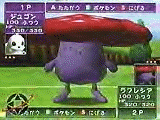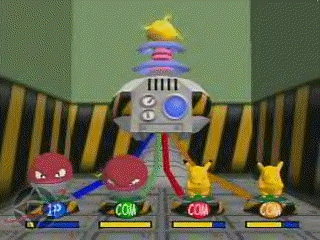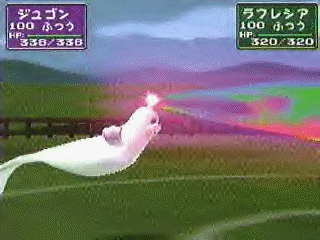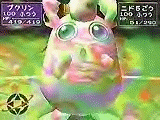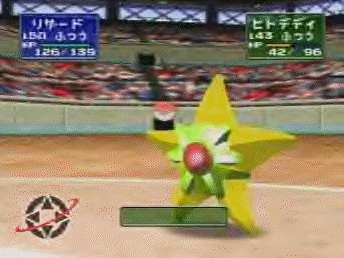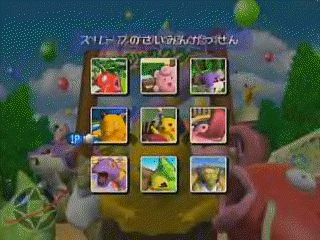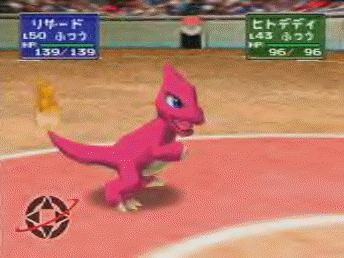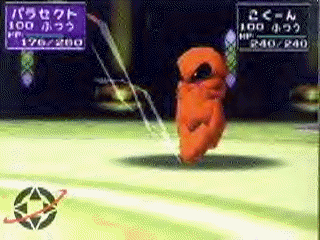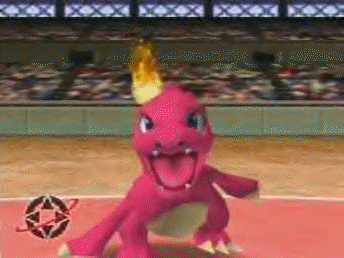E3 Update
Nintendo announced at the show that it
will release the US version of the wildly
popular Japanese monster battle game in
October '99. The game, which will utilize
Factor 5's M.O.R.T. voice compression, is
set to bring the full lineup of Pokemons
to life in polygonal 3D. Like the
Japanese version (called Pokemon
Stadium 2), the US Pokemon Stadium
will ship with the 64GB Pak packed in.
The device plugs into the Nintendo 64
controller pak slot and enables Pokemon
enthusiasts to exchange monster data
between the Game Boy Pokemon titles and
Pokemon Stadium. Other uses for the GB
Pak include data exchange in a number of
upcoming Nintendo games as well as the
import of face textures into Rare's Perfect
Dark from the Game Boy camera.
Pokemon
games are selling well in both Japan and
the US -- and Nintendo will milk the
little monsters for all they got. With Pokemon
Stadium funneling more and more Game
Boy owners over to the N64 in Japan, it's
no surprise then that the sequel is
already on the way.
Although
the first title was only released in
Japan, Nintendo has finally decided to
bring the monster battles stateside with
this second revision of the best-selling
Japanese hit. Instead of giving US
players the more limited Pokemon Stadium
(1), Nintendo of America chose instead to
directly bring Pokemon Stadium 2
to the US and Europe. To make things a
little more confusing (or less, depending
on how cosmopolitan you are), the US
version of Pokemon Stadium 2 will sell
under the moniker of the first title.
Features
32MB/256 megabit
cartridge.
151 Pokemons.
3D polygonal
battle scenes.
All-new gameplay
modes.
Compatible with
the Game Boy titles.
Data exchange via
64GB Pak
The ability to
kick Pikachu (hopefully).
Factor 5 Voice
Compression.
In
case you're not familiar with the first
game, Pokemon Stadium enabled owners of
the Game Boy Pokemon games to load their
monster data to the N64 with the help of
the included 64GB Pak attachment (see
hardware section) and then pit them
against each other in Final Fantasy-style
turn-based battles.
Remember
those turn-based battles in most of the
popular role-playing games like Final
Fantasy? Two (or more) creatures or
humans square off against each other,
enabling the player to input attack
commands and watch the battle. Pokemon
Stadium instantly reminds you of those
RPGs -- minus the quest and storyline.
Confused? You should be.
The
premise behind this type of game genre,
popularized by Pokemon for the Game Boy
and Monster Ranchers for the PlayStation,
is not story or action.
"Collection" and
"training" are the key words.
Unfortunately,
the first Pokemon Stadium didn't include
all the Pokemon monsters from the Game
Boy series and gamers were limited to
only around 40 of them. That's all about
to change.
In
Pokemon Stadium -- or Pokemon Stadium 2
as it is called in Japan, large-scale
battles are now possible with the full
151 Pokemons -- and you will even be able
to have them participate in training
mini-games to get the monster up to
speed.
There
are several new game modes:
Tonikaku
Battle
This mode is easy to play even if you're
not familiar with the Pokemon titles.
This is a kind of learning mode, to break
you gently into the game and teach you
the basics, so you can later graduate to
training and fighting with your own
monsters.
Event
Battle
The Pokemon league mode, set against a
time limit. The two settings you can
control are the "fight
time-limit" and the
"technique-entry time-limit."
Fights can be set to last from 5 to 90
minutes and you can give yourself (and
opponents) anything from 10 to 90 seconds
in which to enter their next technique
(fighting move) -- a 10 seconds isn't too
long! If you're both still standing when
the fight time runs out, the monster with
the most HP remaining wins the bout.
Research
Mode
The mode that allows you to organize a
Pokemon album and swap monster data with
your Game Boy. Plug the Game Boy Pokemon
cartridge into the 64GB Pak and load the
monster data, then view the monsters in
full polygonal 3D and send them into
battle.
Winner's
Castle
The tournament mode which sees you do
battle for six trophies. Pit six of your
monsters up against six of your opponents
at various difficulty levels.
Chibbikko
Club
There are nine types of mini-games in
this mode. Like the regular battle mode,
you don't need detailed knowledge of the
Pokemon universe to enjoy them. You can
participate with up to four players, and
you don't even need to use the Game Boy
cartridge to play this mode. If there are
fewer than four of you playing, the CPU
makes up the numbers.
Free
Battle
A tag-team battle mode for up to four
players, this mode is the sequel's star
attraction. Pitching players in a 2 Vs 2
tag-team match, each person gets to
choose three of the fighters for the team
of six. With up to 12 different types of
Pokemon in the field, it's essential to
have a good all-round knowledge of the
different monsters' capabilities.
GB
Building
The same as in the last game. Here, you
can play the Game Boy version of the game
using your N64. Essentially, the GB
Building is a software emulator that
displays the action of the Game Boy game
on screen in limited color, similar to a
Super Game Boy. Remember that it will
only play Pokemon games, though.
While
gamers were mostly limited to one-on-one
battles in the original Pokemon Stadium,
Nintendo has added a special Ultra Cup
and a total of nine new mini-games to
PokeSta 2. These games let up to four
players go head to head and battle each
other by throwing rocks, hammers and all
kinds of other unpleasant projectiles.
Pokemon
Stadium 2 promises to pump out the same
excellent 3D, 60fps visuals as its
predecessor. The Pokemons square off in
various fighting areas where they will
pull off amazing attacks, such as
Pikachu's lightning bolts that will
literally light up the screen with its
11,000 volt glory.
Outlook
Pokemon Stadium was fun, but it was
limited by its small selection of
monsters. Pokemon Stadium 2 promises to
fix all that and up the ante with a
number of new modes. Nintendo has
announced that it will publish this
verison of Pokemon Stadium in the US
instead of first releasing last year's
Pokemon Stadium (1), so expect to hear a
lot more about the game soon.
|


